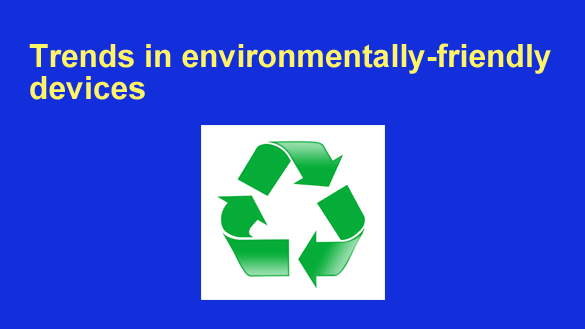 In an era marked by a growing awareness of environmental issues, the technology industry is experiencing a significant transformation. The demand for sustainable and environmentally friendly tech is rising, reflecting a global shift towards eco-conscious consumer choices.
In an era marked by a growing awareness of environmental issues, the technology industry is experiencing a significant transformation. The demand for sustainable and environmentally friendly tech is rising, reflecting a global shift towards eco-conscious consumer choices.
This article explores the latest trends and innovations in sustainable technology, highlighting the impact of sustainable tech on the environment and providing insights into how consumers can make informed choices.
The Rise of Sustainable Tech
The call for sustainable tech solutions is gaining momentum, driven by the ever-increasing concern over electronic waste and energy consumption. The surge in electronic waste, or e-waste, is a pressing issue, with discarded electronic devices contributing to environmental pollution.
Consumers are now seeking eco-friendly alternatives that reduce e-waste and minimize energy consumption, ultimately contributing to a more sustainable future. This shift in demand is pushing the tech industry to embrace new paradigms.
Energy-Efficient Devices
One prominent trend in sustainable tech is the development of energy-efficient devices. Tech manufacturers are creating gadgets that consume less power while maintaining optimal performance.
This trend extends across various categories, from smartphones with energy-efficient processors to laptops with power-efficient displays. Not only do these energy-efficient devices help reduce electricity consumption, but they also lead to longer battery life, offering added convenience for users.
Sustainable Materials and Design
Sustainable tech is not only about energy efficiency but also eco-conscious materials and design principles. Tech companies are now incorporating recycled and biodegradable materials into their products, reducing the environmental impact of manufacturing processes.
Sustainable design extends to device packaging, often featuring eco-friendly materials and minimalist, recyclable packaging designs. This emphasis on sustainable materials and design appeals to environmentally-conscious consumers and sets a positive example for the industry.
Extended Product Lifecycles
Another pivotal shift in sustainable tech involves extending the lifecycles of electronic devices. Tech manufacturers are embracing modular and repairable designs, allowing users to upgrade and repair their gadgets, thus reducing the frequency of device replacements.
These devices are engineered to last longer, addressing the issue of planned obsolescence and encouraging users to keep their tech tools for an extended period. This approach saves consumers money and helps reduce e-waste, contributing to a more sustainable tech landscape.
E-Waste Recycling and Circular Economy
Promoting responsible e-waste recycling is a crucial component of sustainable tech. In response to the growing e-waste crisis, a circular economy approach has emerged in the tech industry, emphasizing the importance of recycling and reusing electronic components.
Tech companies and organizations are working to establish systems that facilitate the refurbishing and reutilization of electronic parts and devices. These efforts are eco-friendly and economically beneficial, creating opportunities for the tech industry to minimize waste and reduce its environmental footprint.
Emerging Trends and Innovations
Sustainable tech is a dynamic field, constantly evolving to meet the growing demand for eco-conscious solutions. Recent trends include the development of solar-powered gadgets that harness renewable energy sources, reducing reliance on conventional power grids.
Additionally, using biodegradable materials in electronic components is gaining momentum, further minimizing the environmental impact of discarded tech. Eco-conscious packaging and shipping practices are also rising as tech companies recognize the importance of reducing packaging waste and carbon emissions.
Emerging trends and innovations in sustainable tech continue to reshape the industry, fostering a tech-savvy and environmentally responsible future.
Making Informed Choices
For consumers looking to make eco-friendly tech choices, several key factors must be considered. First, research and evaluate product certifications and eco-labels to ensure a device meets sustainable standards.
Additionally, consider the energy efficiency and power consumption of gadgets and the materials used in their construction. Assess the product’s repairability and upgrade options, as devices designed for longevity can significantly reduce e-waste.
Making informed choices and supporting tech companies prioritizing sustainability is a crucial step towards a more eco-friendly tech landscape.
The Impact of Sustainable Tech on the Environment
The adoption of sustainable tech trends has a profound impact on the environment. By reducing electronic waste and minimizing energy consumption, sustainable tech benefits individual consumers and contributes to a greener, more sustainable future.
The collective efforts of tech companies, consumers, and environmental initiatives are poised to make a significant difference in reducing the environmental footprint of the tech industry. As these trends evolve, we can anticipate a future where tech innovation and environmental responsibility go hand in hand, forging a path towards a cleaner and more sustainable world.
The future of sustainable tech is bright and promising, with ongoing developments in eco-friendly technology shaping the industry. From energy-efficient devices to sustainable materials and extended product lifecycles, sustainable tech trends offer a greener and more responsible path for the tech industry.
By staying informed and making eco-conscious choices, consumers can play a significant role in supporting these trends and contributing to a more sustainable future. The shift towards eco-friendly tech isn’t just a trend; it’s a movement towards a more environmentally responsible and innovative tech landscape.